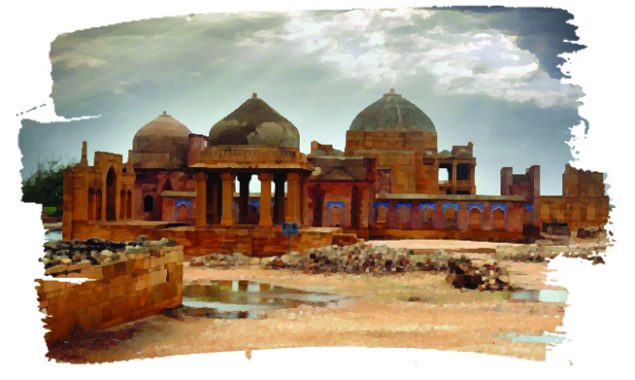
The historic necropolis of Makli tells a story of Sindh’s rich history
It is widely believed that the Sufi, poet and scholar Shaikh Jamali established a Sufi retreat, otherwise known as a khanqah, at Makli, where he was eventually buried. Many years later, Jam Tamachi, a 14th century Samma ruler, declared that he wished to be buried near Sufi Jamali. Thus began the traditional of using Makli as funerary site.
The historic location grew to particular prominence during the Samma dynasty, which had its capital nearby. Eventually, with so many of the affluent class of the time decreeing to be buried there, it lead to the creation of the one of the largest historic necropolises in the world.
Makli, which is located on a plateau roughly six kilometres away from Thatta near the apex of the Indus River Delta, houses as many as one million tombs built over the course of 400 years. The city stands as a testament to the historic civillisations of Sindh between the 14th to the 18th centuries, and was therefore declared a United Nations Educational, Scientific and Cultural Organisation (UNESCO) World Heritage site in 1981. As a burial site for the rich and famous of the time Makli houses tombs and monuments for Royalty, governors, saints, scholars, philosophers and the like, made from stone, brick and, in many, cases glazed tiles.

Some of the most famed historical figures laid to rest their include, Jam Nizamuddin II, who reigned from 1461 to 1509, lsa Khan Tarkhan the Younger and of his father, Jan Baba, both of whose mausolea were constructed before 1644. Meanwhile, a monument to behold belongs to Diwan Shurfa Khan who died in 1638.
Since Malki was used as graveyard over many centuries by many different civillisations, the architecture found in its many massive structures, spanning a little over 10 kilometres, are of multiple different varieties. According to UNESCO, the graveyard has structures that exhibit a fusion between indigenous and outside influences.
“These influences include, among others, Hindu architecture of the Gujrat style and Mughal imperial architecture, meanwhile distant Persian and Asian examples of architectural terra-cotta were also brought to Makli and adapted,” it claimed. Through the variety of architectural influences in the necropolis, historians have been able gain key insights into the social and political history of the ancient Sindh between the 14th to 18th centuries.
Integrity and preservation
According to UNESCO, Makli exhibits all the elements and components necessary to express the Outstanding Universal Value (OUV). However, due to continuous neglect by successive government and locals alike, the integrity of the property is threatened. Furthermore, local climatic conditions, including earthquakes, variations in temperature, winds containing salts and humidity, heavy rains and the natural growth and shift of the riverbed contribute to the destruction of the necropolis.
Encroachments and pilferage also add to the already existing degradation of the property.
“The historical monuments at Makli, Thatta, are authentic in terms of their forms and design, materials and substance, and locations and setting, [however], because elements of the property are in an advanced state of decay and disintegration, the authenticity of the property is threatened,” alerted UNESCO.
Experts have repeatedly suggested that this is likely to continue unless scientific actions are taken to reduce the ongoing human and environmental threats to the heritage site. This is because government action alone has not been enough, due to its consistent lack of implementation.
As it stands, Makli is protected under the Antiquities Act of 1975 under the Constitution of Pakistan. However, with the introduction of the 18th Amendment the domain of its preservation and protection falls under the helm of the Sindh government.
The United Nations has detailed that, the site is, “staffed by a curator, archaeological conservator, technical assistant, supporting staff, attendants, and funding from the Sindh government.”
However, on ground the reality is quite different, as this funding is not being spent to protect the site in the way that it should be. To sustain the OUV status awarded to Makli by UNESCO, the property must be given due attention, through a thorough development and protection strategy.
Read More News On
Catch all the Pakistan News, Breaking News Event and Latest News Updates on The BOL News
Download The BOL News App to get the Daily News Update & Follow us on Google News.




